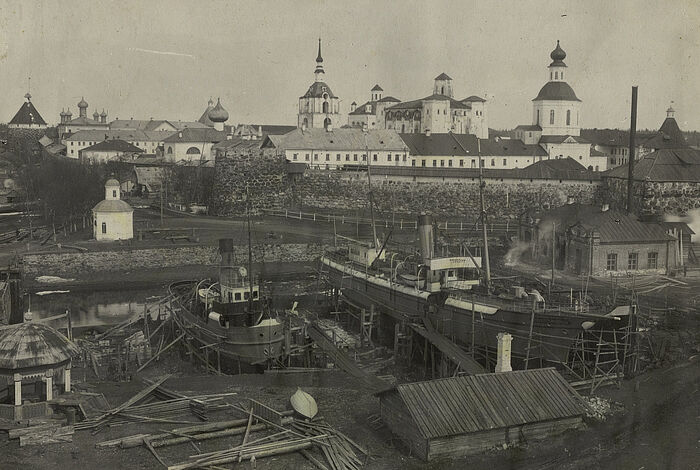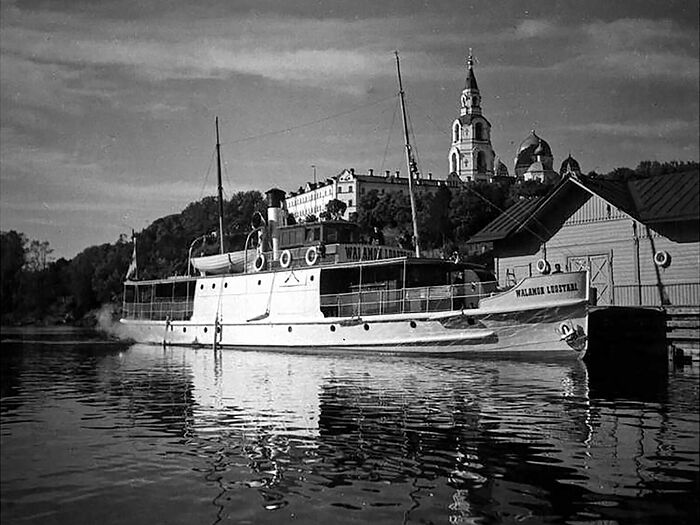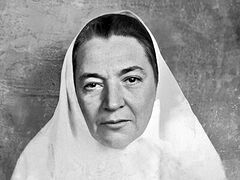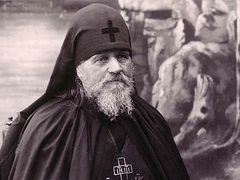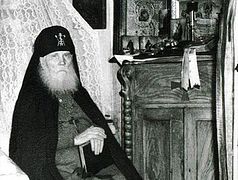This article talks about the life of Nikolai Ivanovich Egorov, the future Archimandrite Dmitry, who escaped the Solovki camps and entered Valaam Monastery as a novice in the 1930s. Later, he founded several sketes in America, where he reposed in 1992.
Since the 1990s, when they opened the archives, the number of studies on the history of camps in the USSR has been growing, including on those who escaped from camps. Among other things, some reports on the activities of the Solovki camp administration have become known. Researchers believe that the frequency of escapes depended on the effectiveness of the security in a particular place or region, the time of year, the general development of the punitive system, and also the strength of spirit of the prisoners themselves.1 Of the recent research, it’s worth mentioning the work of Fr. Vyacheslav Umnyagin;2 also of great interest are the published recollections of those who successfully escaped, presented, among other places, in the wonderful series, “Recollections of Solovki Prisoners,” edited by Fr. Vyacheslav.
The fugitives who left memoirs also included clergy. One of the most well-known is the recollections of the former Solovki prisoner Fr. Michael Polsky,3 who fled from exile to Komi in 1929, which were published in Palestine in 1931.4 He wrote that in escaping from Soviet Russia he was saving not so much his life as his soul. Considering himself weak, he was afraid that in his country he would “betray the truth for which he fought.”5 Another Solovki prisoner, Archimandrite Theodosy (Almazov)6 saw “the Providence of God” in his escape.7
Finland was the nearest country to escape to, and the lucky ones who reached it saw it in a rosy light at first, especially considering the rather cordial welcome they received. Hatred of the Bolsheviks and the lawlessness they committed was one of the factors consolidating Finnish society. Of course, the refugees were quarantined and interviewed by the police, who were nevertheless sympathetic to them. Archpriest Simeon Solodovnikov (1883–1939),8 who fled the USSR in 1930, for example, wrote that the interview was like a friendly conversation. The refugees were fed, clothed, accommodated; Fr. Simeon even played the violin.
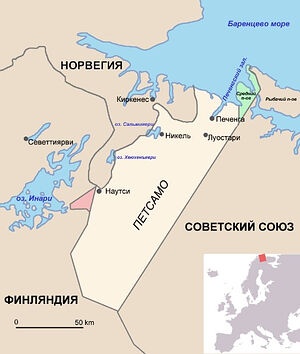 The Petsamo Province, through which Solovki refugees passed to Finland Refugees would come across the St. Tryphon of Pechenga Monastery in Petsamo, where in 1921–1931 the abbot was the Valaam monk Igumen Iakinf—later to become the famous elder Schema-Abbot John (Alekseev). For example, the aforementioned Archpriest Simeon Solodovnikov, who fled with his family in 1930, turned to him. He recalled how they shot after them at the border and wounded one of his sons. In Finland, they operated on him for free and saved his life. The story of the Solodovnikovs made it into the papers. The archpriest based his flight from the USSR on the need to educate and raise his children, which he didn’t want to do in an atheist state. There is also evidence that the fugitives were fired at on the border, from both sides.
The Petsamo Province, through which Solovki refugees passed to Finland Refugees would come across the St. Tryphon of Pechenga Monastery in Petsamo, where in 1921–1931 the abbot was the Valaam monk Igumen Iakinf—later to become the famous elder Schema-Abbot John (Alekseev). For example, the aforementioned Archpriest Simeon Solodovnikov, who fled with his family in 1930, turned to him. He recalled how they shot after them at the border and wounded one of his sons. In Finland, they operated on him for free and saved his life. The story of the Solodovnikovs made it into the papers. The archpriest based his flight from the USSR on the need to educate and raise his children, which he didn’t want to do in an atheist state. There is also evidence that the fugitives were fired at on the border, from both sides.
The escapes are known and described in detail in the published memoirs—they leave no doubt that every such escape was a real miracle and would have been impossible without the help of God. For without it, it would have been impossible to endure the unbearable hardships of the road. However, the inhuman torments that the prisoners suffered in the Solovki camps undoubtedly gave them the strength to not look back. Nevalainen writes dryly: “The refugees reached the borderland of Karelia and Northern Finland having overcome huge distances through the thickets of the forest, their legs bloodied; they were gnawed by mosquitoes and falling over from exhaustion. It’s known that some of the refugees … lost their way and died in the forest.”
In 1926, Finland closed the border, which increased the number of those involved in illegal smuggling. Nevalainen mentions two Ingrians who escaped from the Solovki camp through a logging site in Karelia in 1930—Aatami Kuortti and Mikko Kisseli Kuortti, who was a pastor in North Ingria and was sentenced to ten years in prison in the Solovki camp for his religious activities. But he managed to escape before arriving at Solovki and walked 185 miles to Finland.
One of those who successfully fled from Solovki to Finland was the future archimandrite Dimitry (Egorov). He made it to Valaam Monastery on Ladoga and remained there as a pilgrim-novice. His name in the world was Nikolai Ivanovich Egorov. Little is known of his life, partly because he didn’t like to talk about himself, considering that a monk should forget his past and his secular life. On the other hand, he wanted to protect his relatives who remained in Soviet Russia. According to preliminary data, he was born in 1907 in the city of Shatsk, Tambov Governorate. There is contradictory information on this point. A. Nivier says he was arrested after the Tambov uprising and exiled to the Solovki camp in 1925–1926. Some articles say that he fled to Finland by crossing the Barents Sea in winter. Thus, he would have been eighteen at the time he was arrested. On the other hand, the Tambov uprising was in 1920–1921, when he was still a teenager.
Rare memories from the Elder’s spiritual children have been preserved. Metropolitan Jonah (Paffhausen) has said that Nikolai Egorov was arrested in Moscow and escaped from Solovki only on the second attempt:
I came under the guidance of Archimandrite Dimitry (Egorov) in 1979. When I met him, he was already quite old and was reluctant to talk about himself… I know he grew up in Moscow and studied medicine in the 1920s. He was arrested for possession of and reading the Bible and was sent to Solovki. The clergy who were serving time there baptized the young man.
He spent two years on Solovki, then he and a friend secretly made skis and planned an escape in winter. They walked through the woods for several days and then reached a village, but they were afraid to enter. They continued to roam, his friend froze, and he found himself back in the camp. He was punished for escaping by being deprived of his rations. He didn’t die in the camp—he survived. The death of his friend was really hard on him and he decided he must now live and labor for two.
He dreamed of becoming a Valaam monk, but he only managed to live on Valaam as a novice…
Fr. Dimitry lived as a hermit for many years; he acquired unceasing prayer and was a bit of a fool for Christ. Later, when he was already quite sick, he lived at Holy Assumption Monastery in Calistoga, California. He pastored the nuns and helped everyone who wanted to lead a monastic life in California.
He was clairvoyant; in Confession, he always knew everything I’d done. He always had words for me that left a mark in my heart. He had the gift of spiritual discernment. I felt a strong spiritual connection with him; I felt his prayer for me. He became my spiritual father, which was a blessing from God.9
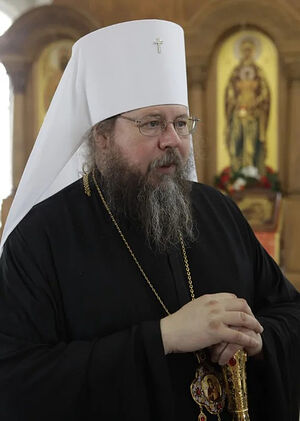 Metropolitan Jonah (Paffhausen) The idea of Nikolai having a secret Baptism on Solovki raises doubts—children born long before the revolution were usually baptized in infancy. Perhaps he came to conscious faith in the camp by communicating with the ascetics who were there. The Elder never fully mastered English. Little is known about the details of his life in the camp and his escape. The American version of his biography says that Nikolai was exiled to Solovki (“a group of small islands in the White Sea”) for ten years for “counter-revolutionary activity,” that he was severely beaten by jailers in the camp,10 and when he managed to escape, they released the dogs after him, but they didn’t catch him.
Metropolitan Jonah (Paffhausen) The idea of Nikolai having a secret Baptism on Solovki raises doubts—children born long before the revolution were usually baptized in infancy. Perhaps he came to conscious faith in the camp by communicating with the ascetics who were there. The Elder never fully mastered English. Little is known about the details of his life in the camp and his escape. The American version of his biography says that Nikolai was exiled to Solovki (“a group of small islands in the White Sea”) for ten years for “counter-revolutionary activity,” that he was severely beaten by jailers in the camp,10 and when he managed to escape, they released the dogs after him, but they didn’t catch him.
Nikolai was a novice-pilgrim at Valaam until 1935. During his escape from the camp, he got frostbite in his legs and he had to have part of his foot amputated. In the monastery, he carried out his obedience in the library and helped Igumen Chariton (Dunaev) prepare a book about the Jesus Prayer, gathering quotes from the works of the Holy Fathers. Then he left to study at the St. Serge Theological Institute in Paris. He was under the jurisdiction of Metropolitan Evlogy (Georgeivsky), whom he called a “bright person.” He was tonsured a monk on June 6, 1936. On June 14, he became a deacon. He was ordained a hieromonk by Metropolitan Evlogy at the St. Serge Podvoriye in Paris on February 28, 1937. His classmates at the institute would say that Fr. Dimitry was probably the “most Orthodox” of all the students of the school, and that meant he didn’t completely fit in. They called him a “typical Russian village peasant.” Nevertheless, he loved the people—it wasn’t nationality or education that mattered to him, but the salvation of their souls.
In 1937-1938, he was head of Holy Trinity Church in the Paris suburb of Ozoir-la-Ferrière. Then, in 1939, he was the second assistant to the rector of the Church of the All-Merciful Savior in the city of Asnières, and served at the Holy Resurrection Convent and a home for the elderly in Rozay-en-Brie near the city of Melun. In 1940, he started serving in the Skete of All Saints of Russia in the city of Mourmelon. In 1944, he started serving at the Church at the old folks’ home in Rozay-en-Brie again. He served at the Church of All Saints of Russia in the Sainte-Geneviève-des-Bois Cemetery in the Russian House near Paris.
In 1947, he was mentioned as rector of the Church of St. Nicholas the Wonderworker in the city of Sens, but now in the jurisdiction of the Russian Exarchate of the Patriarchate of Constantinople. Then he moved to San Francisco by invitation of Archbishop John (Shahovskoy), and on March 4, 1948, he was received as a cleric of the North American Metropolia of the Russian Church. In 1948-1949, he served as an assistant priest in Holy Trinity Cathedral. From 1949 to 1963, he served at Holy Protection Church in Santa Rosa. In 1954, his friend from Valaam Monastery, Hieromonk Mark (Shavykin), also moved to the U.S., becoming a priest in 1969.
In the early 1950s, the Lewry family from San Francisco donated seventeen acres to the diocese in the picturesque Point Reyes forest area in Marin County, California. It was supposed to be used as a monastery in memory of their son Eugene, an American soldier who died in World War II. The monastery was to be named in honor of the holy warrior-martyr Eugene and they were to pray for the repose of Eugene Lewry. Fr. Dimitry, disappointed with the hustle and bustle of parish life and perhaps Church politics, retired to this donated land and lived there as a hermit. The American version of his life states that in 1951, he received a blessing from Archbishop John (Shahovskoy) to found a monastery on this land. With the help of Orthodox friends in the Russian community, Fr. Dimitry built two small buildings on the new land: A house with two cells and a small chapel and trapeza/guest house. Selectively cut trees from the site and old building materials were used for the construction. At the beginning of the monastery’s life, there were no provisions, and Fr. Dmitry’s first “cell” was an army tent, followed by a hut measuring ten by eight feet, heated by a wood stove.
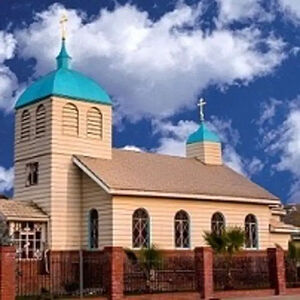 Church of the Holy of Myrrh-bearers in Sacramento, California In 1963, Hieromonk Dimitry was elevated to the rank of igumen. On April 7, 1969, he was elevated to the rank of archimandrite. In 1983, he was appointed rector of the Church of the Holy Myrrh-bearers in Sacramento. In 1986, he retired and moved to Santa Rosa, where he served the sisters of the Skete of the Kazan Icon of the Mother of God, which he had founded. They took care of the Elder who was seriously ill, suffering from Type 2 diabetes, heart problems, and cancer. In the last years of his life, Fr. Dimitry suffered at least two strokes, which confined him to a wheelchair.
Church of the Holy of Myrrh-bearers in Sacramento, California In 1963, Hieromonk Dimitry was elevated to the rank of igumen. On April 7, 1969, he was elevated to the rank of archimandrite. In 1983, he was appointed rector of the Church of the Holy Myrrh-bearers in Sacramento. In 1986, he retired and moved to Santa Rosa, where he served the sisters of the Skete of the Kazan Icon of the Mother of God, which he had founded. They took care of the Elder who was seriously ill, suffering from Type 2 diabetes, heart problems, and cancer. In the last years of his life, Fr. Dimitry suffered at least two strokes, which confined him to a wheelchair.
He reposed on June 13/26, 1992, in the Kazan Skete, and was buried in the Oak Mound Cemetery in Healdsburg. After leaving Valaam, he adhered to the old calendar his whole life.

